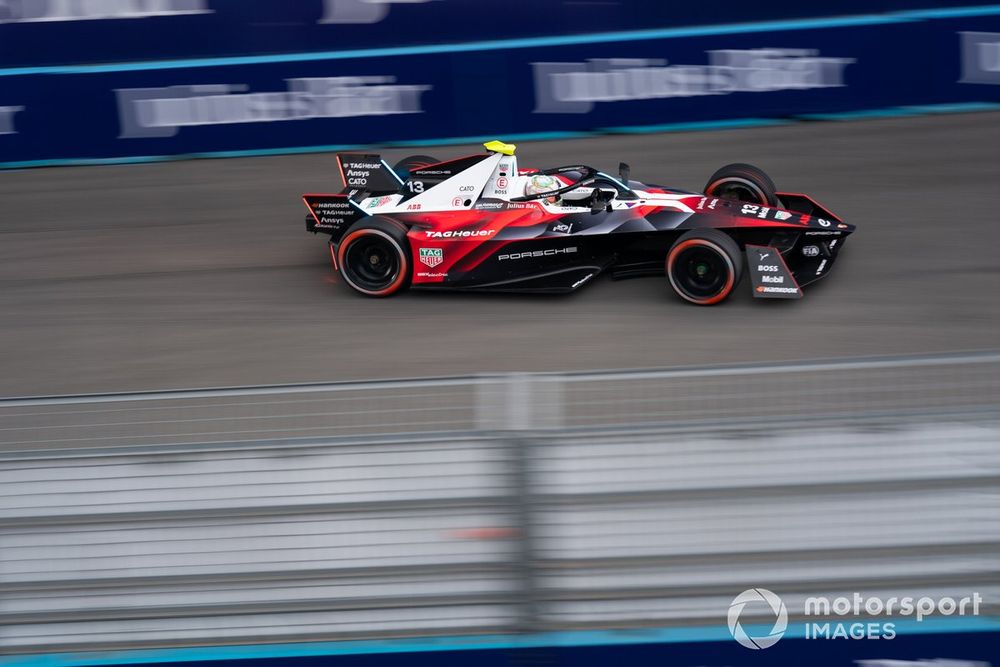
“I don’t believe they have the technical expertise enough to regulate a world championship like us with all these manufacturers and drivers. They are not good enough.”
As racing driver outbursts go, it doesn’t get much more damning than that. But, fresh with the raw emotion of having just been stripped of a well-earned second place in Formula E's first London E-Prix last month, Antonio Felix da Costa’s reaction against officials in the drivers’ media pen immediately after perhaps came as no surprise.
What was more of a surprise, in fact, was to learn that the low air pressure on his front right tyre was, he claimed, due to a slow puncture which he had nursed over the final five laps of the race. An impressive feat, but one which earned Porsche driver da Costa a three-minute penalty due to a technical infringement – that being that the pressure went below the minimum safety level set out by tyre supplier Hankook and Formula E.
Da Costa and Porsche were left angry and subsequently appealed, but fast forward to last week and the stewards dismissed the right of review on the grounds that there was “no significant and relevant” new material. The matter is still set to go before the FIA’s International Court of Appeal which will be heard at a later date, though, so the matter still rumbles on.
If successful in overturning the decision it would alter things, with Porsche moving ahead of customer team Andretti Autosport in the teams’ championship, while da Costa would jump from ninth to fifth in the drivers’ standings. But more than the championship positions gained, the bigger ‘win’ would be quashing any speculation that this was anything other than unfortunate circumstances rather than something untoward.
Insight: Ranking the top 10 Formula E drivers of 2022-23
Da Costa claimed that the puncture had been caused by running over debris and there was certainly enough of it about as two red flags truncated the end of the race, which raised further questions around the consistency of penalties.
Several cars were left with broken front wings due to incidents prior to both the first and second stoppage in London, with the decision taken by some teams not to replace the heavily damaged bodywork. Doing so would have meant the driver would be required to cycle to the back of the pack, and with so few laps remaining and little performance drop-off a number of cars went back out for the restarts minus the front wing.

This included Norman Nato and Sam Bird, who took fifth and sixth on-the-road, as did Sergio Sette Camara who finished directly behind them. But the NIO 333 driver was eventually disqualified from the result because the team had ignored a direct instruction from the FIA technical delegate to replace the damaged front wing at the second red flag. The team deemed the damaged part to be safe, ignored the instruction and claimed the Brazilian had already been running with the damaged part after the first red flag.
According to the FIA, in this particular case, “some cars were asked to change the front nose because some elements were either loose or the absorption impact structure was damaged and therefore, they were considered unsafe”.
While it’s not 100% clear whether all damaged cars were inspected by the FIA delegate, it raises a very big question. If a front wing is clearly broken, or any major component of a car for that matter, can it really be considered safe when it is no longer serving the purpose it was designed for? It’s a grey area to say the least but one which was even more baffling given events only two weeks earlier.
It’s easy to understand why they must feel aggrieved, knowing that officials allowed cars with noticeable damage to be allowed to race, not only in London but at other venues
In Rome, Nato had been allowed to continue with a notably damaged front wing after the Nissan driver made contact with Jake Dennis early in proceedings. Despite the bodywork visibly trailing along the ground for most of the race, no decision was taken by race control for Nato to pit and replace the part.
PLUS: How a "complete reset" helped Dennis deliver Andretti's Formula E title
An FIA spokesperson confirmed after the race that “as per process, we’ve monitored the situation throughout the entire race with all the tools at our disposal and the car was considered safe to race”. The tools in question included TV images as well as CCTV footage not shown on the live broadcast, while Scot Elkins, the FIA race director, can communicate directly with teams and drivers as and when needed.
All this followed on from Nico Muller’s 27g crash in Portland at the previous round when he lost steering after his front wing became lodged under his car. The Abt Cupra driver was thankfully unhurt in the collision, but it was a clear example of just what can go wrong.
Looking at the da Costa and Porsche case again, the tyre pressure did fall below the minimum threshold and, following the letter of the law, it’s difficult to see how the original decision will be overturned when it’s heard in front of the ICA. But it’s easy to understand why they must feel aggrieved, knowing that officials allowed cars with noticeable damage to be allowed to race, not only in London but at other venues.
What the case has done, though, is shine a light on those decisions made by officials. We often hear that there can be no comprise when it comes to safety, and rightly so, but it’s difficult not to feel like decisions which could have very real consequences are being made on an ad hoc basis. And, as da Costa says, that’s not good enough.








